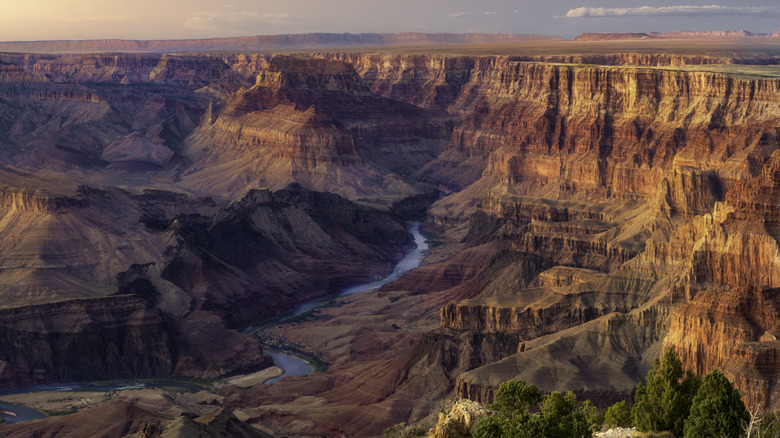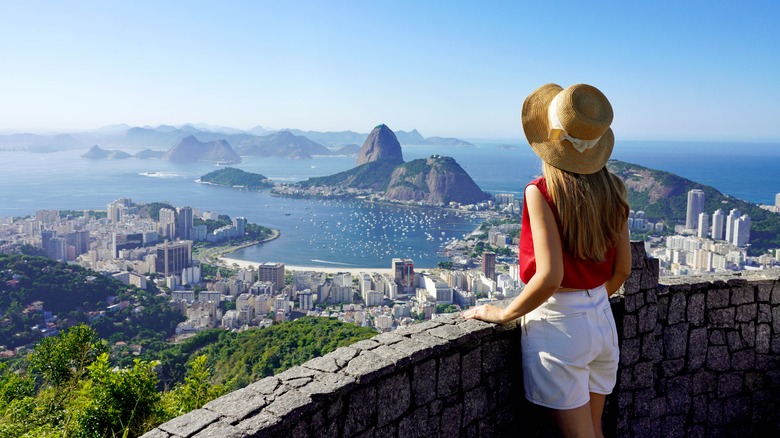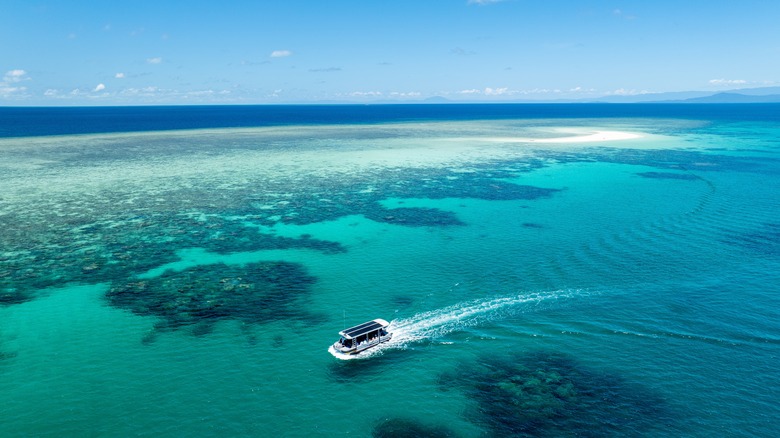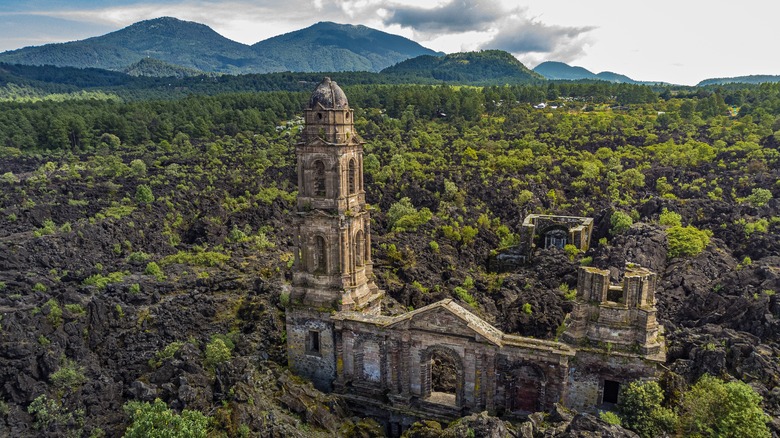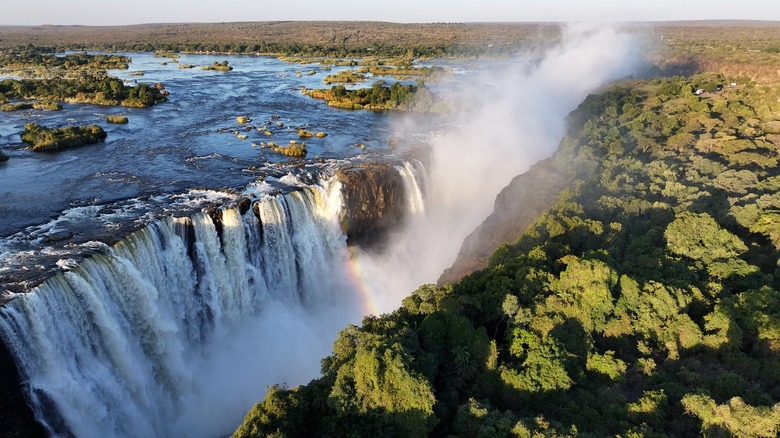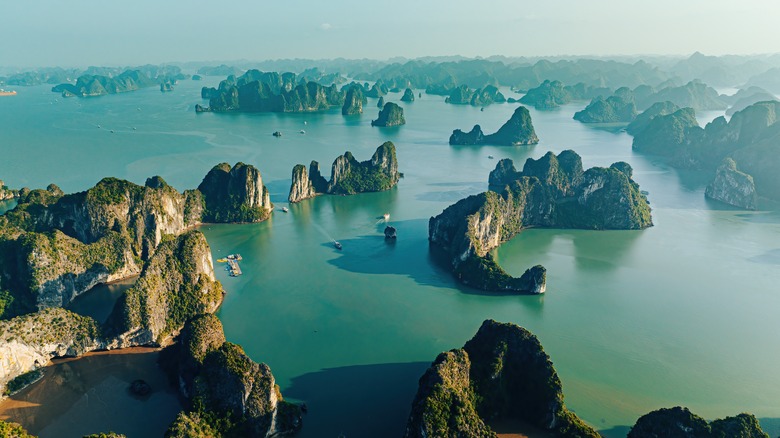The Seven Natural Wonders Of The World Belong On Your Bucket List
We may receive a commission on purchases made from links.
You're probably no stranger to the Seven Wonders of the World, even if, in a pinch, it's hard to name them all. Granted, it's a little tricky because there are actually a few "seven wonders" lists — with the original dating back more than 2,000 years ago! Worse yet, the original list's ancient monuments, except for the Pyramids of Giza, have mostly gone the way of the dodo. But a "New Seven Wonders" list, compiled in 2000 by a private foundation, highlights destinations that still exist — like Petra, the Colosseum, and Machu Picchu.
Arguably, there are even more destinations and attractions that should be considered wonders of the world. Almost all of these cultural treasures have been around for hundreds, if not thousands, of years. There's the millennia-old Mayan city of Chichén Itzá, the incredibly long Great Wall of China, and the Taj Mahal, an unparalleled 17th-century mausoleum. The only exception is Rio de Janeiro's Christ the Redeemer statue, which started construction in 1926. That said, it just so happens that this monumental landmark oversees one of the Seven Natural Wonders of the world, too.
From canyons large enough to create their own weather to a massive volcano that rose from a farm field literally overnight, some features of Earth simply defy imagination. Selected by an organization known as Seven Natural Wonders, the list reflects landscapes and phenomena that stop us in our tracks and make us go, "Wow." Or even, "How?!" And while this total number of terrestrial wonders certainly doesn't end here, let one, two, or all seven of these natural places inspire your next bucket list trip.
The Grand Canyon, U.S.
At well over a mile deep, Arizona's Grand Canyon is a painter's palette of color, with sedimentary rock layers dating back hundreds of millions of years. In fact, along the South Rim, the Trail of Time is an easy, 2.83-mile hike that doubles as a geologic timeline, where every meter (about 3.2 feet) you walk represents a mind-boggling one million years. The oldest rock in the Grand Canyon is well over a billion years old. Plus, its dramatic changes in elevation means that the canyon even creates its own weather! Luckily, visiting is easy, thanks to the National Park Service.
The best times to visit Grand Canyon National Park are in the spring between March and May, and in the fall between September and November. The temperatures then are relatively cool, albeit unpredictable, and you can expect thinner crowds. Even so, finding solitude in the Grand Canyon is still possible on less-traveled, beautiful backcountry routes. Don't discount winter, though! While it may get cold, the weather can be crystal clear, and seeing this otherworldly landscape coated in snow is a real treat.
The most popular views of the Grand Canyon are typically found along the South Rim. This area can be easily reached from numerous parking lots, as well as on the long, paved, pedestrian-only Rim Trail that's accessible for wheelchairs and strollers. While the North Rim is typically a less crowded destination for astonishing views from a slightly higher elevation, a devastating wildfire in 2025 destroyed more than 145,000 acres, which means it currently remains closed. Instead, head to lookouts like The Abyss, for the South Rim's deepest vertical drop, or Hopi Point, for dreamy sunset views. Alternatively, get up early and catch the sunrise from Mather, Yavapai, or Bright Angel points.
Harbor of Rio de Janeiro (Guanabara Bay, Brazil)
Of Brazil's most iconic sights, Sugar Loaf Mountain and the Art Deco-style Christ the Redeemer statue probably pop to mind right away. Towering over one of the largest natural harbors in the world, these landmarks tell us we've arrived in the Harbor of Rio de Janeiro — also known as Guanabara Bay — which boasts a circumference of more than 31 miles. Standing tall above the bay, the Christ the Redeemer statue, completed in 1931, is one of the most iconic structures in the country. Clocking in at 98 feet tall atop the 2,310-foot Corcovado Mountain, this remarkable sculpture is also considered one of the New Seven Wonders, thanks to its colossal scale and its global recognition as an emblem of Brazil.
Arguably, the best way to experience this amazing waterscape is by boat — exploring the history and natural granite formations that shape the harbor. Hop aboard a sightseeing cruise for amazing photo opportunities in either the morning or at sunset as you sail past the Museum of Contemporary Art on the shore of Niterói, designed by acclaimed 20th-century architect Oscar Niemeyer, and the dramatic Santa Cruz citadel. On foot, visitors can hike around Tijuca National Park, one of the world's best hiking destinations in this vibrant city where jungle trails meet iconic beaches.
Another marvelous way to take in this expansive area is by air, whooshing over the beaches and whizzing past the Christ the Redeemer statue in a helicopter. Tours of around a half-hour to 45 minutes offer unparalleled views of the bay's unique mountains, including an option to take a doorless helicopter ride, where you can snap your favorite pair of sneakers dangling out over landscapes you'll never forget.
The Great Barrier Reef, Australia
Situated off the northeast coast of Australia, the Great Barrier Reef is one of the most spectacular marine ecosystems in the world. In fact, the reef is Earth's largest living structure and can even be seen from outer space. It also covers around 133,000 square miles, making it the largest coral reef system anywhere on the globe. More than 900 islands dot the region, which is actually composed of around 2,500 individual reefs home to clownfish, jellyfish, manta rays, sea turtles, and thousands of other creatures.
For a five-star hospitality experience on this stunning part of the Queensland coast, head to resorts like Niramaya in Port Douglas, or Bedarra Island Resort on Bedarra Island, for amazing views over the water. On the other end of the spectrum, fun-loving hostels like Global Backpackers Cairns, Magnums Airlie Beach, and YHA Cairns — the latter even has a pool — offer beds on a budget.
Your best bet for great weather is to visit between June and November. That said, November is also the start of jellyfish season, or "stinger season," which lasts until May. Nonetheless, divers can wear lycra stinger suits for protection while enjoying the sights. As for heading underwater, snorkeling and scuba diving cruises make the most of a whole day out on the water. Alternatively, you can also head out via ocean raft or on a glass-bottom boat cruise. Although this saltwater wonderland is all about sea life and swimming — and, sure, maybe a spa treatment or two — don't forget the magic of soaking up 360-degree views from the air. Scenic flights via small plane around areas like the Whitsundays or departing from Cairns provide an astonishing perspective from which to enjoy turquoise waters and seemingly endless, ecologically diverse coral reefs.
Mount Everest, Nepal
Mount Everest is the kind of destination that bucket lists are made for. The peak is the highest point on Earth above sea level, and although it's not technically the biggest mountain in the world — that distinction goes to Mauna Kea in Hawaii, which sits largely underwater — Everest is an expert mountaineer's dream climb. At 29,904 feet, it's definitely an undertaking. How long it takes people to climb Mount Everest largely depends on the weather, coordinating safe routes with sherpas, and building in enough time to acclimatize to the higher altitude. Thankfully, those among us who don't want to train extensively, or spend two months climbing this famously mercurial mountain, can still experience this natural wonder.
If you've got a couple of weeks to spare and are up for an adventure of a lifetime, you can hike to Mount Everest Base Camp with the help of tour companies like Amazing Nepal. To embark on the trip, you'll fly from Kathmandu to Lukla, where you'll set off on a multi-day trek to the famous mountaineering base, located at 17,450 feet above sea level. There, you can see surrounding peaks like Lhotse, Pumori, and Nuptse, and observe the remarkable glacier below you. If a day trip is more your style, set off via helicopter with Global Holidays Adventure. Stopping for lunch at the historic, mid-century-modern Hotel Everest View, you can stay overnight and experience sunrise over the peaks.
Anyone who takes to these Himalayan heights should be aware of symptoms like headaches and stomach discomfort — effects of what the locals call "lekh lagnu," or mountain sickness. Symptoms can vary from person to person, but just remember to take it slow, drink enough water, avoid coffee and alcohol, and you'll be in for a great visit.
Aurora Borealis
Of all of the natural world wonders on this list, aurora borealis, or the Northern Lights, is the only one that doesn't correspond to a specific location. We have the sun and its solar storms to thank for this phenomenon, which is caused by enormous clusters of electrically charged particles. When some of the particles get caught in Earth's magnetic field, which is more concentrated at the poles, we're treated to curtain-like lights that range from green, to pink, red, blue, and purple.
In northern Norway, for example, you can often see the lights from late September through to late March. For a memorable experience in this Arctic wonderland, book an overnight stay in one of a handful of hotels that take winter lodging to a whole new — and, quite literally, icy — level. Two great options include Tromsø Ice Domes and Snowhotel Kirkenes.
Meanwhile, in Alaska, especially around Fairbanks, viewing time is usually optimal between mid-August and mid-April. Iceland also attracts visitors to its northern climes to see the aurora borealis between September and April. Companies like Hidden Iceland, for example, lead private tours that include luxury accommodations and a chance to see glowing skies. The country's Westfjords are worth a jaunt if you want to escape the crowds while taking in the amazingly scenic, remote landscape. And, while there's no guarantee that you'll see the Northern Lights on a winter trip, it's not difficult to make the most of a visit to these unique Arctic destinations. From skiing in Finnish and Swedish Lapland to learning about Sàmi culture, taking a reindeer-led sleigh excursion in Norway, or riding behind a team of sled dogs, you'll find plenty more to do and see.
Paricutín Volcano, Mexico
Paricutín is one of the most dramatic volcanoes you've likely never even heard of. Located near the city of Uruapan in Michoacán, Mexico, this cinder cone volcano sprang into action unexpectedly back in 1943, when it began spewing lava and ash from a rural farm field. In its first 24 hours, Paricutín rose 164 feet. During its nine-year eruption, it grew to a total of 1,391 feet, with a lava field that covered 90 square miles. The geological marvel made the list of natural world wonders because it's the first volcano scientists have been able to observe from its earliest development until its eventual dormancy in 1952
Although Paricutín's eruption buried the village of San Juan Parangaricutiro, you can still visit the area and climb around the now-hardened lava, which left only the local church facade and tower remaining. If you'd like to climb the volcano itself, a great trail begins in the town of Angahuan and covers 14.6 miles on an out-and-back route. It's definitely a challenge, though, as you'll head up the steep cone and gain just over 2,700 feet in altitude before heading back down. Visitors have also noted that the trail composition becomes more difficult as you climb higher due to the soft, volcanic sand. That said, the opportunity to peek into the deep crater and across the mountainous region is definitely worth it!
Afterward, your best bet for finding a cozy place to relax after a good hike around Paricutín is in Uruapan. Here, a welcoming courtyard awaits at Hotel Mi Solar, or you can choose to relax poolside at Hotel Mansión del Cupatitzio. Whatever you do, don't miss live music, cerveza, and mixed drinks in the surprisingly inviting warehouse setting of La Charandería.
Victoria Falls, Zimbabwe
Spilling dramatically over a series of basalt gorges along the border of Zambia and Zimbabwe, Victoria Falls is one huge waterfall. It holds the distinction as the world's largest sheet of falling water, extending about 5,600 feet wide, and its famous spray can be seen from at least 18 miles away in both Zambia and Zimbabwe. This fine mist is an attraction unto itself: aside from prismatic rainbows you can enjoy during the daytime, a full moon is also bright enough to create ethereal lunar rainbows, or "moonbows," in the air. As such, tours often run during the night of the full moon, as well as one day before and after, giving you a chance to see this unique phenomenon.
To really get a sense of the scale of Victoria Falls, climb into a helicopter for an aerial tour. From the air, you can also see more of the Zambezi River and, flanking it on both sides, Zambezi National Park and Mosi-oa-Tunya National Park. Keep an eye out for giraffes, elephants, buffalo, and more along the river.
Back on the ground — relatively speaking — head to Batoka Gorge, into which Victoria Falls spills, and strap into a harness for an adrenaline-filled zipline ride. From nearly 400 feet above the water, you'll sail across 1,400 feet at up to 65 miles per hour. Numerous lookouts on both the Zimbabwean and Zambian sides of the falls offer great views of different features from the ground. For another way to enjoy the beautiful Zambezi River and its plethora of wildlife, hop aboard the Zambezi Breeze for a sunset dinner cruise, which includes a chance to spot elephants, hippos, and more from the water while tucking into a dinner of local cuisine.
More world wonders worth a visit
Throughout history, cultures around the world have found creative and ingenious ways to express their heritage, beliefs, and ways of life. The Pyramids of Giza, for example, were constructed around 4,500 years ago as tombs for Egyptian pharaohs during the Old Kingdom, and they were designed to last for eternity. And, boy, did they ever. When the original list of the Seven World Wonders was compiled in the 2nd century by a Greek writer named Antipater of Sidon, the pyramids were already more than two millennia old. And yes, you can explore inside the Pyramids of Giza, where you'll find deep chambers and ghostly stone sarcophagi. None of the others he include in his list, like the Hanging Gardens of Babylon, or the lighthouse of Alexandria, exist today. Nonetheless, plenty of destinations categorized as the New Seven Wonders are well worth an addition to your bucket list. This includes the Colosseum, Petra, Chichén Itzá, Christ the Redeemer, the Great Wall of China, Machu Picchu, and the Taj Mahal.
And, of course, the natural wonders of the world aren't limited to the seven listed above. If you ever find yourself in Cape Town, South Africa, you can't miss the city's dramatic backdrop of the flat-topped Table Mountain. Then, there's Hạ Long Bay, in Vietnam — an incredible archipelago consisting of 1,133 islets in an array of dramatic shapes and sizes. And, of course, don't forget the Amazon! A rainforest that covers about 40% of South America, you can take in beauty of the Amazon Rainforest from a national reserve on the border of Bolivia and Peru, or head to Manaus, Brazil's gateway to the region.
Methodology
The formulation of this list began with the official record compiled on the 7Wonders and Seven Natural Wonders websites, both of which were published following a 1997 CNN report that highlighted global and continental phenomena. Similarly, the New Seven Wonders of Nature site has also produced a separate list, determined through a popular vote. That said, we focused on the so-called "original" list, as it provided the impetus for this last one.
To help us determine the best ways to experience these locations or phenomena, we researched websites for specific locations, including the official National Park Service website, dedicated country and destination websites, and the International Commission on Geoheritage. In some cases, we referenced specific travel agencies that specialized in tours to gain a better understanding of these destinations. For visitor experiences, we focused on reviews and ratings available on sites and discussion forums like Tripadvisor, Google Maps, and Reddit. Finally, for specific information about aurora borealis, we also relied on information compiled by the NOAA Space Weather Prediction Center.

